Geology of a Vernal Pool
Vernal pools are a very special wetland, that provides habitat for species that would not exist without them. To fully appreciate a vernal pool, one must first understand that these are not just a puddle. Puddles are something completely different, and may hold water long enough to attract breeding amphibians, but often dry up leaving amphibian larvae stranded. To appreciate these unique wetlands, one must first examine the geological characteristics of a vernal pool.
The presence of a vernal pool requires a supportive combination of topography, water sources, soils and cover.
Topography
Vernal pools hold standing water, which means they are restricted to depressions in the ground, that are isolated from other water bodies. With that said, there may be few small or shallow temporary drainage paths into or out of vernal pools, as is the case at this location. The location of a Vernal pool may not have anything to do with the water table. At times, water can become trapped by the underlaying bedrock, creating a low infiltration rate, and holding runoff above the water table, creating a perched water pool. However, vernal pools can also be supported by a regional water table, when groundwater levels intersect the pools bottom. These groundwater-supported vernal pools are more frequent in floodplains and on landforms with coarse-textured soils within glacial outwash plains and moraines.
PERCHED WATER TABLE
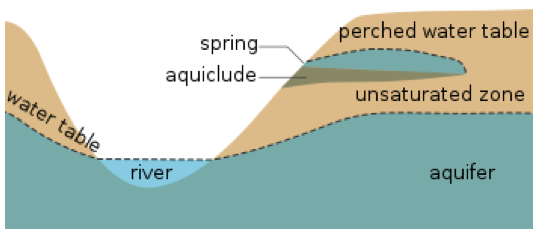
Soils
Soils within vernal pools typically reflect the local soil types and hydrology. Soils in perched situations overlay shallow bedrock or contain fine materials, such as clay, silt, and muck. If a vernal pool is connected to the water table they will likely have coarse soils such as sand or gravel to allow for the seepage of water, in from the water table.
The soils typically have indicators of prolonged wetness, including a lack of layering, settling, a decay odor, may also contain layers of roots and surface debris. Since vernal pools are found in forests only, all pools receive an annual deposition of tree leaves, which plays important role in maintaining the life of vernal pools.
Water Quality / Chemistry
Water quality and chemistry in vernal pools is controlled by a large number of factors. Vernal pools in landscapes with igneous bedrock such as granite will likely have a lower pH (i.e. higher acidity). Vernal pools in landscapes with (or derived from) sedimentary bedrock such as limestone have higher concentrations and higher pH (i.e. lower acidity).
Vegetation
Vernal pools are completely surrounded by forests. Areas without the forest environment are likely an emergent marsh, wet prairie or wet meadow.
Common Types of Vernal Pools
Vernal pools form in a variety of ways. The position of a vernal pool on the landscape can suggest its origin. Here are a few common origins of vernal pools.
Floodplain Vernal Pools
Vernal pools are often formed in the floodplains of streams and rivers. During floods, a stream will overflow its banks and enter the floodplain where the rushing high waters scour pockets in the floodplain. Some of these pockets retain water well and become vernal pools. The natural meandering of a stream channel across a floodplain over the years can also create vernal pool habitats in the form of oxbow wetlands.
FLOODPLAIN VERNAL POOL
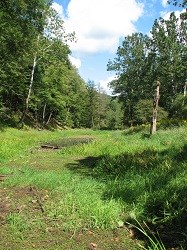
Glacial Vernal Pools
During the last ice age, glaciers once covered Southern Ontario. As glaciers moved and shifted, they created many isolated depressions, through the actions of ice melt, scour, and erosion that fill with precipitation and snowmelt.
GLACIAL VERNAL POOL
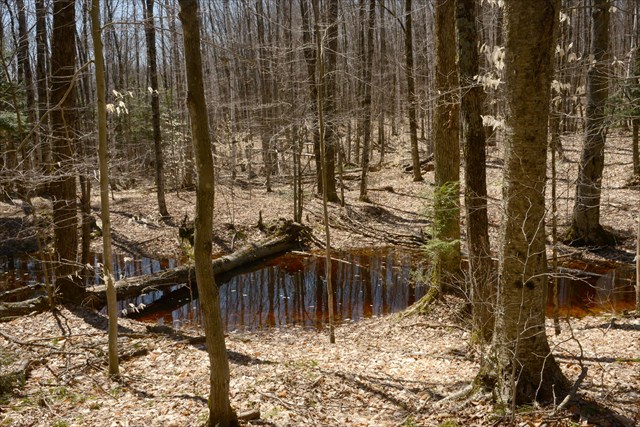
Sag Pond Vernal Pools
A sag pond is a body of water collected in the lowest parts of a depression formed between two sides of an active strike-slip zone. Sag ponds may be useful identification features in aerial photographs for mapping faults. Surface water gathers in the depression but the impermeable layer in the soil restricts surface water infiltration and creates a perched water table. Sag ponds of various sizes can be found along the San Andreas Fault in California, the Carrizo Plain and Sierra Palona Mountains.
FORMATION OF A SAG POND VERNAL POOL
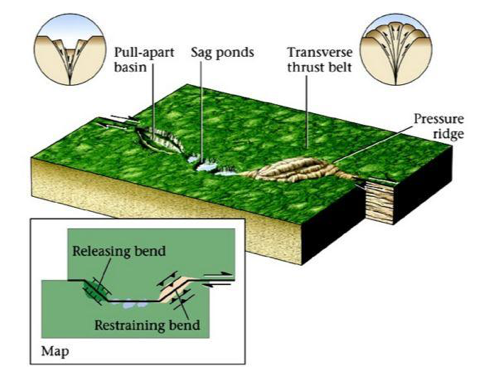
Pingo Vernal Pools
Pingos can only form in a permafrost environment. Evidence of collapsed pingos in an area suggests that there was once permafrost. Pingos are formed by freezing and thawing processes on moist slopes. The upper layers of soil thaw first and slowly slide over underlying frozen soils. The resulting landscape appears to be scarred with crescent shaped wetlands. Open canopied pingos are often full of marshy vegetation. Pingo vernal pools frequently have groundwater influences.
Human Created Vernal Pools
Some vernal pools are created deliberately by people who wish to create wildlife habitat or to replace a seasonal wetland that was destroyed. Other pools are inadvertently created during human activities. Artificially created pools can support vernal pool wildlife if the surrounding upland habitat is relatively intact and the water quality of the artificial pool is adequate. Vernal pools can form in pits dug during surface mining operations, borrow pits, roadside ditches, agricultural fields, and other artificially created shallow depressions that hold water long enough to support seasonal pool wildlife.
HUMAN CREATED VERNAL POOL
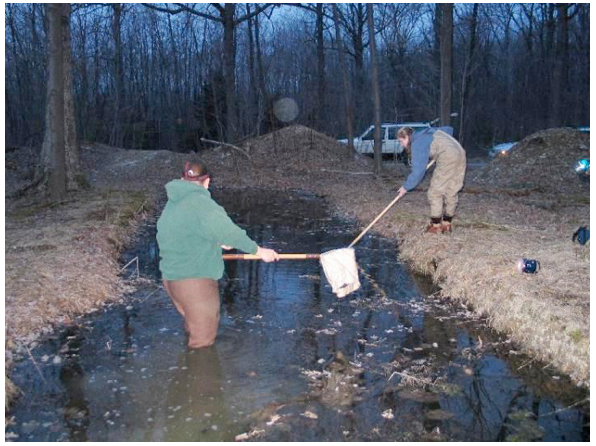
Life in the Pool
Vernal pools (also called vernal ponds or ephemeral pools) are temporary pools of water that provide habitat for distinctive plants and animals. They are a wetland without fish, allowing for the safe development of amphibians and insect species unable to withstand competition or predation by fish. The key defining feature of vernal pools is that they typically dry up by the middle of the summer.
VERNAL POOL SEASONAL CHANGES

As a result, populations of frogs, salamanders and invertebrates thrive. Some species are highly adapted to the wet-dry cycle of these pools and come to depend on it for successful reproduction. These obligate species, and it is their presence, which distinguishes vernal pools from an ordinary puddle.
Wood Frog (Rana sylvatica), fairy shrimp, salamanders and the nationally threatened Jefferson Salamander (Ambystoma jeffersonianum) are dependent on vernal pools for reproduction.
In Ontario, vernal pools are threatened habitats due urban development, deforestation, and poor land and water management and conservation practices.
To claim the find for this EarthCache, answer the following questions, and submit them to the CO at the top of this cache page.
Questions:
1) Describe the amount of water in the Vernal Pools near GZ, and what phase you feel it is in.
2) Estimate the size (approximate surface area = length x width) of the vernal pool, and your prediction of the depth from the boardwalk. (Do not disturb the vernal pool)
3) Describe the area surrounding the vernal pool, to speculate why a vernal pool has formed in this landscape.
4) Identify where you see (or believe - in the drier seasons) the temporary drainage paths (into or out of) may be for the vernal pool you observe here.
5) Do you believe this vernal pool is a perched vernal pool, or does it receive direct support from the ground water table. Use information from the cache page to support your observations at GZ.
6) Take a close look at the vernal pool in front of you. Use the Cache description to determine the possible geological origin of the vernal pool in front of you.
7) Based upon the cache page, and the information found at GZ, what unique qualities of this vernal pool make it an ideal habitat as a nursery for amphibians
Optional Photo Opportunity
8) At the additional waypoint, there is a unique photo opportunity. Put on your very salamander smile, and snap away. We’d love to see the photos!
References:
https://mnfi.anr.msu.edu/abstracts/ecology/vernal_pool.pdf
http://www.naturalheritage.state.pa.us/VernalPool_Geology.aspx
https://en.wikipedia.org/wiki/Vernal_pool
https://www.epa.gov/wetlands/vernal-pools
http://www.vernalpool.org/vpinfo_1.htm